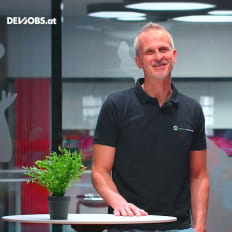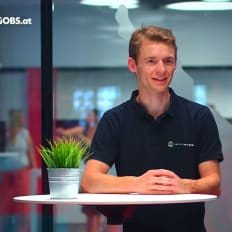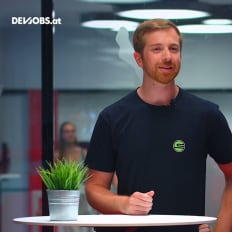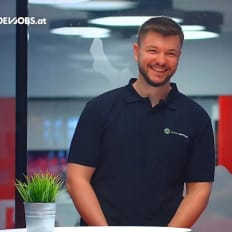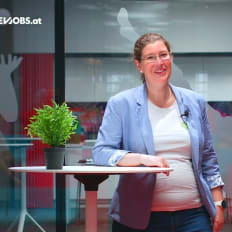
solvistas GmbH
Michaela Raab, Data Scientist bei solvistas
Description
Michaela Raab von solvistas gibt im Interview Einblicke in ihren Background, sowie ihren aktuellen Job als Data Scientist und gibt Tipps für Neueinsteiger.
By playing the video, you agree to data transfer to YouTube and acknowledge the privacy policy.
Video Summary
In “Michaela Raab, Data Scientist bei solvistas,” Michaela Raab traces her path from high school graduation to studying Statistics and Data Science, adding Business Informatics, completing a master’s in Statistics, and turning an internship at solvistas into a full-time Data Scientist role. She outlines the end-to-end scope at solvistas—from data collection and preparation through analysis, visualization, and forecasting—and advises prioritizing curiosity about data, understanding what can be done with it, and attention to data quality over any specific background.
From Statistics to End-to-End Data Science: Michaela Raab’s Journey at solvistas
A practical path fueled by curiosity
In the session “Michaela Raab, Data Scientist bei solvistas” with speaker Michaela Raab (Company: solvistas GmbH), we heard a concise yet insightful account of how a data scientist grows into end-to-end responsibility. Starting with studies in Statistics and Data Science, adding Business Informatics as a second degree, completing a Master’s in Statistics, and building experience through internships—including one at solvistas—Raab describes a steady transition from studies to a full-time role. The through line is clear: deliberate choices, a commitment to learning, and a holistic view of the data lifecycle.
As the DevJobs.at editorial team, we listened for the milestones and the mindset: What does “responsible for the entire process around data” look like in practice? How do internships become stepping stones rather than mere line items? And why might curiosity and care for data quality matter more than the exact academic label on your CV?
The foundation: Statistics, Data Science, and a business lens
Raab’s first major choice after the Matura set the foundation: Statistics and Data Science. That combination signals a desire to understand data deeply—from collection to inference to decisions. She later made a decisive addition with a second degree in Business Informatics, explaining she wanted “a business background” on top of her statistical studies. That isn’t a detour; it’s a deliberate complement.
For data work that drives outcomes in organizations, context is everything. Business Informatics supplies the vocabulary and structures to understand processes, stakeholders, and the way systems connect. Paired with statistics, it creates a profile that moves comfortably between rigorous methods and real-world use cases. Listening to Raab, it’s evident she doesn’t think in isolated models but in end-to-end flows—how data travels from source to decision.
Praxis matters: Internships and a gradual move into full-time work
Alongside her studies, Raab deliberately invested in practice. “I did internships again and again,” she notes; one of those took her to solvistas. From there, the handover to a working life was gradual: she stayed on as a Data Scientist, expanding her hours during her studies, and eventually transitioned into a full-time position. It’s a simple arc that underlines a powerful idea: internships are not just trial runs; they’re growth environments.
That growth-through-practice approach closes the loop between theory and real constraints—formats, messy inputs, stakeholder goals, iteration cycles. For many data scientists, this is where a career takes shape: by applying methods to actual data and evolving along with project scope and responsibility. Raab’s path illustrates how a smooth, staged transition can sharpen skills and confidence in the process.
End-to-end ownership: “responsible for the entire process around data”
How does Raab describe her role at solvistas? She puts it bluntly:
“As a Data Scientist at solvistas, you are responsible for the entire process around data.”
She then sketches the stages of that lifecycle in her own words:
- Participate in data collection
- Receive data from clients
- Prepare data for analysis
- Guide the client through the analysis
- Visualize results
- Build forecasts and predictions
This is a broad remit, and that’s the point. The job isn’t a thin slice of the pipeline; it’s the whole journey—from source to insight. Responsibility means caring about quality, context, and impact at every step. You need breadth and structure, plus a clear sense of what the data is ultimately supposed to help decide.
What early involvement in data collection implies
Raab emphasizes that the role starts before the first record arrives. Thinking about data at the source—definitions, measurement points, protocols—prevents rework later. Early alignment lays the groundwork for consistency. The message between the lines is clear: quality begins upstream.
Taking client data and making it usable
“We get the data from the clients,” Raab says, reflecting the lived reality of most projects. Data rarely arrives in perfect shape. Formats differ, fields are missing, domain specifics creep in. That’s why preparation for analysis isn’t just preprocessing—it’s the key to unlocking trustworthy results. Turning raw inputs into a solid analytical foundation is a core contribution.
Guiding the analysis in collaboration
Raab speaks of “accompanying” clients through analysis. That word matters. It suggests a non-siloed process, with feedback loops, transparent assumptions, and decisions made in dialogue. Accompaniment means communicating intermediate findings, aligning on goals, and adjusting methods with the user in mind.
Visualization and prediction—two necessary capabilities
Raab lists visualization alongside forecasts and predictions. Together they highlight a crucial pairing: models must be communicated, not just built. Visualization makes insights accessible and actionable; predictions provide a view forward. Both are necessary for end-to-end accountability.
The core competence: understanding data more than labels
Asked what matters most in the role, Raab focuses on a simple, demanding idea: “a certain understanding of the data.” And she underscores that the path to that understanding can vary:
It’s “not that important what the background is,” whether it’s “from HTLC,” from “the private sphere,” or “through studies.” What matters is “finding data exciting” and knowing “what can be done with data.”
That’s both inclusive and rigorous. It sets the bar at curiosity, comprehension, and responsibility. If you find data exciting, you’ll probe origins, constraints, and definitions. If you know “what can be done with data,” you look past tools to impact: Which decisions are at stake? What risks come from misreading? What transparency is necessary along the way? Raab’s emphasis shifts attention from collecting credentials to cultivating a professional stance toward data.
Data quality: the quiet determiner of success
Raab’s comment on quality stands out, delivered matter-of-factly:
Topics like “data quality” should be interesting—and “thought along with” the work.
In practice, quality often determines whether projects succeed. It’s not a checkbox; it’s the condition for meaningful analysis. Three implications that follow from her emphasis:
- Quality begins at the source: early involvement improves consistency and reduces downstream effort.
- Quality is contextual: a number is only as good as the definition, measurement, and domain framing behind it.
- Quality is collaborative: preparation, analysis, and visualization all depend on shared understanding and care.
If you find quality “interesting,” you won’t only react to issues when they blow up; you design against them proactively. That distinction separates “data that exists” from “data that delivers.”
Where statistics meets business: building bridges between method and impact
Raab’s mixed academic background is a practical advantage. Statistics provides the methodological spine; Business Informatics bridges to processes, systems, and stakeholders. In projects where data informs decisions, that dual perspective pays off:
- Method selection: statistical grounding helps you choose techniques intentionally and explain assumptions clearly.
- Process awareness: Business Informatics adds understanding of system interactions, interfaces, and requirements—vital for data flows and implementation.
- Communication: translating across domains—engineering, business, management—becomes easier when you can “speak” multiple professional languages.
Her trajectory underlines that it’s not an either/or choice. Effective data work in organizations is process work. That requires both depth and connectiveness.
Growing by increments: from side jobs to full-time ownership
One line encapsulates a pragmatic growth strategy: build your role “more and more” alongside your studies until, eventually, you’re a full-time Data Scientist. It’s growth through stages—responsibility expanding with experience. What starts as an internship can turn into ongoing project involvement, then into a full role.
For a field as fast-moving as Data Science, that iterative growth is powerful. Rather than locking into a narrow role too early, you mature along the lifecycle, seeing where quality, collaboration, and communication intersect. Raab’s path shows that flexibility and practice enable you to step into end-to-end responsibility with confidence.
What we at DevJobs.at took away from the session
From Raab’s concise remarks, we distilled lessons relevant to aspiring and seasoned data scientists alike:
- End-to-end thinking is a skill: it’s not just modeling. It’s source-to-decision accountability—collection, preparation, analysis, visualization, and prediction working in concert.
- Practice shapes profiles: internships aren’t just access points. They’re growth environments where theory confronts reality and skills sharpen around real constraints.
- Understanding beats labels: the precise background matters less than curiosity, comprehension, and care for data.
- Quality isn’t a side topic: build it in early, define it in context, and carry it through to visualization and prediction.
- Bridge competencies matter: statistics plus business understanding makes it easier to work across stakeholders and deliver outcomes.
All of that sounds straightforward—and remains demanding in day-to-day work. Raab’s story demonstrates that it’s achievable when learning loops are intentional and responsibility grows step by step.
Practical takeaways for day-to-day work
How might you apply these insights in your own projects? A few suggestions aligned with Raab’s emphasis:
- Seek early involvement: ask about definitions, measurement points, and ownership before data is collected at scale. Upstream clarity pays off downstream.
- Treat preparation as core work: document transformations and assumptions. Don’t treat data cleaning as an afterthought—it’s leverage.
- Prefer accompaniment to handover: think of analysis as a guided process with iterative alignment and transparent decision points.
- Use visualization as an argument: design visuals to explain assumptions and support decisions, not just to decorate reports.
- Make predictions with humility: surface assumptions, link forecasts to data quality and context, and communicate uncertainty.
- Cultivate curiosity: identify what excites you about data—it sustains you through complexity and helps you prioritize.
Quotes that stick
A few lines from Michaela Raab capture a professional ethos:
“As a Data Scientist at solvistas, you are responsible for the entire process around data.”
It’s less about the specific background and more about “finding data exciting,” knowing “what can be done with data,” and keeping “data quality” in mind.
These lines emphasize responsibility, curiosity, and quality—an inviting message for talent entering the field from varied paths, whether through school, private projects, or academic programs.
Why this profile resonates
What stands out about Raab’s journey is the compounded effect of deliberate choices: build a statistical foundation, add a business lens, integrate practice early, and embrace end-to-end accountability. In an era where technical careers are often defined by tool stacks, Raab’s perspective centers on the substance of data work: understanding, care, and the ability to bring people along with insights.
Her trajectory at solvistas also hints at how organizations can empower effective data science: by shaping roles that don’t isolate a single phase of the pipeline but support ownership from source to visualization and prediction. That’s where value materializes for clients and teams alike—decisions become more grounded, patterns more visible, and the path forward more legible.
Looking ahead: the next learning loop starts now
Even though the session was compact, it painted a clear picture of how Data Science careers grow—in stages, with practice, and with an eye on quality. Following Michaela Raab’s example—connecting study with internships, adding a business perspective, and caring deeply about data quality—builds experience that holds up across tools and trends.
The invitation to the community is simple: think end to end, walk back to the source, and cultivate curiosity alongside accountability. The next learning loop starts now—with the next dataset, the next assumption to check, the next visualization to design. That is where professional posture forms—and where Data Science becomes more than models: it becomes impact.
More Dev Stories
solvistas GmbH Jochen Falkner, Senior Data Scientist bei solvistas
Jochen Falkner von solvistas erzählt im Interview von seinem Weg in die IT, den Aufgaben als Senior Data Scientist und welche Ratschläge er Neueinsteigern mitgeben würde.
Watch nowsolvistas GmbH Fabian Weißenböck, Software Developer bei solvistas
Fabian Weißenböck von solvistas redet in seinem Interview über seine Anfänge mit dem Programmieren, was er aktuell in seiner Arbeit macht und was seiner Meinung nach wichtig für Beginner ist.
Watch nowsolvistas GmbH Theo Crazzolara, Data Engineer bei solvistas
Theo Crazzolara von solvistas gibt im Interview Einblicke in seine Anfänge mit dem Programmieren, was er täglich im Data Engineering zu tun hat und was seiner Meinung wichtig für Beginner ist.
Watch nowsolvistas GmbH Markus Hiesmair, Software Engineer bei solvistas
Markus Hiesmair von solvistas erzählt im Interview über seinen Werdegang als Software Engineer – angefangen von der Schulzeit bis hin zur aktuellen Arbeit – und gibt Tipps für Neueinsteiger.
Watch nowsolvistas GmbH Mateo Adzaga, UX Designer bei solvistas
Mateo Adzaga von solvistas redet im Interview über seine Tätigkeit als UX Designer, wie er damit begonnen hat und was er selbst gerne als Anfänger gewusst hätte.
Watch nowsolvistas GmbH Sophie Brückl, Product Owner bei solvistas
Sophie Brückl von solvistas teilt im Interview ihre Erfahrungen beim Wechsel vom Software Development hin zur aktuellen Arbeit als Product Owner und welche Tipps sie jenen gibt, die ähnliche Schritte planen.
Watch now

